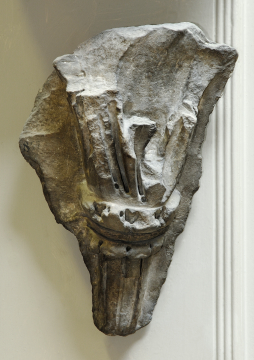Explore Collections


You are here:
CollectionsOnline
/
Foliage fragment from a large Corinthian (or Composite) capital
Browse
Foliage fragment from a large Corinthian (or Composite) capital
Mid 2nd century
Luna marble
Height: 27cm
Width: 18cm
Width: 18cm
Museum number: M857
On display: Dome Area
All spaces are in No. 13 Lincoln's Inn Fields unless identified as in No. 12, Soane's first house.
For tours https://www.soane.org/your-visit
Curatorial note
Fragment of the foliate cauliculus of a Corinthian capital. As The Dictionary of Architecture notes, the use of this term by Vitruvius (IV,1) has not been successfully explained, "in consequence of doubts whether the word was meant by him to express one of the eight stalks, each carrying a double leaf"1, or to indicate the double leaf itself.
Comparison with a large capital from the Forum of Trajan and now set at the side of the Via dell' Imperio indicates that this is a small fragment from another member of this series undoubtedly chopped apart for use as a building material or burning into lime.2 That the style suits work of the period to the middle of the Second Century at Ostia is indicated by an example from the Basilica of that port city.3 The drill techniques found here were used in monumental work as far back as the Augustan era not only in numerous examples in Rome but in centres such as Aquileia.4 Another captial in Aquileia5 and its parallels in the Forum in Rome show the ultimate descent of this taste in Corinthian capitals as late as the middle of the Third Century AD.
1 A.P.S. Dictionary, C., p.51.
2 Compare also the capital found used as building material in the medieval wall of the Tor di Conti and possibly from the Forum Pacis, Colini in Bullettino della Commissione Archeologica Comunale di Roma, LXV, 1937, p.27, fig.16.
3 Becatti, in Bullettino della Commissione Archeologica Comunale di Roma, LXXI (1943-45), 1945, p.38 ff., fig.7.
4 Compare V. Scrinari, I Capitelli romani di Aquileia, Padua, 1952, nos. 25, 17.
5 Loc. cit., no 32.
Comparison with a large capital from the Forum of Trajan and now set at the side of the Via dell' Imperio indicates that this is a small fragment from another member of this series undoubtedly chopped apart for use as a building material or burning into lime.2 That the style suits work of the period to the middle of the Second Century at Ostia is indicated by an example from the Basilica of that port city.3 The drill techniques found here were used in monumental work as far back as the Augustan era not only in numerous examples in Rome but in centres such as Aquileia.4 Another captial in Aquileia5 and its parallels in the Forum in Rome show the ultimate descent of this taste in Corinthian capitals as late as the middle of the Third Century AD.
1 A.P.S. Dictionary, C., p.51.
2 Compare also the capital found used as building material in the medieval wall of the Tor di Conti and possibly from the Forum Pacis, Colini in Bullettino della Commissione Archeologica Comunale di Roma, LXV, 1937, p.27, fig.16.
3 Becatti, in Bullettino della Commissione Archeologica Comunale di Roma, LXXI (1943-45), 1945, p.38 ff., fig.7.
4 Compare V. Scrinari, I Capitelli romani di Aquileia, Padua, 1952, nos. 25, 17.
5 Loc. cit., no 32.
Rome.
Soane collections online is being continually updated. If you wish to find out more or if you have any further information about this object please contact us: worksofart@soane.org.uk


